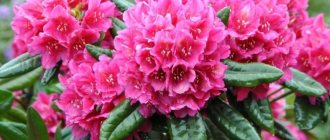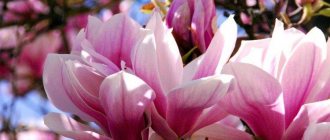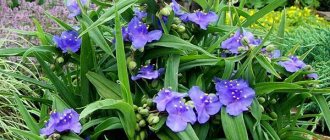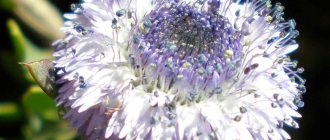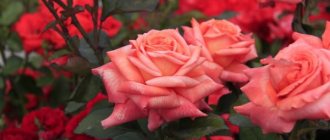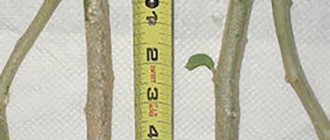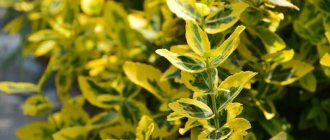Do you want your garden to turn into a celebration of color from spring to summer? So, look at the bright and unforgettable representative of the heathers - the azalea. The popularity of garden azaleas is growing every year, and frost-resistant plant varieties can withstand temperatures down to -30 °C and winter quietly in open ground. All you need to do is position the plant correctly and create favorable conditions for it.
Briefly about care
| Type of agricultural operation for caring for garden azaleas | Description of conditions and actions |
| Watering and air humidity | After the soil surface has dried, water with settled water at a distance of 20 cm from the center of the bush (acidify the water with citric acid once a month). In extreme heat, the bush is sprayed |
| Location organization | A flat area with partial shade, sheltered from drafts and flooding by spring waters, good if there is a garden or park pond nearby |
| Favorable neighborhood | Spruce (tap root), linden with small leaves, oak |
| Optimal temperature conditions | In summer +20 °C +25 °C, in winter it can withstand up to -27 °C -32 °C |
| Planting and transplanting | Beginning of March or September |
| Soil requirements | Garden soil is mixed with sand, turf, a sufficient layer of drainage (crushed red brick, crushed stone) is placed at the bottom of the hole, and pine needles, sawdust or shavings, and mown grass are used as mulch. |
| Fertilizer application | During the budding-flowering period, the plant requires potassium and phosphorus, and after flowering, the azalea is watered with a solution of phosphorus-potassium fertilizers (1:2) |
| First flowers | 3-4 years after planting in April-May |
| Trimming | Sanitary pruning is done in early spring, and formative pruning is carried out after the flowers have withered. |
Watering
Lack of moisture is especially dangerous for young plants. In the first year of rhododendron's life in the garden, take care of regular watering of the flower. On particularly hot days, do this every day. However, do not overdo it with the amount of water. Remember, wet soil is detrimental to the delightful knotweed.
Watering azaleas at home is carried out with the same regularity as garden rhododendron. The only thing you need to do is remove excess water from the pan. Unlike garden species, home rhododendron loves spraying.
Azalea bonsai will fit perfectly into your interior
Remember! If your azalea leaf turns yellow or falls off, you have given the plant too much water. Reduce the frequency of watering.
Description of the plant
Azalea is the collective name of a large group of beautiful flowering shrubs from the genus Rhododendron. It is difficult to characterize the varieties of garden azaleas with general characteristics, since the cultures have many differences:
- grow to a height of three meters or barely rise above a 50-centimeter curb;
- lose their leaves annually or are classified as evergreen;
- bloom at different times.
Garden azalea (azalea)
However, each azalea growing in the garden has a number of characteristics that distinguish the shrub from other plants. Thin shoots with light brown bark are covered with green dense leaves of a vague elliptical shape. The surface of the leaf blade is covered with small hairs.
The root system is located close to the soil surface and is highly branched. During flowering, the tops of the shoots are covered with a scattering of colorful funnel-shaped flowers.
The duration of flowering depends on the variety and growing conditions of the bush: some delight with flowers for a little more than three weeks, others decorate the garden for more than 3 months.
Kinds
Inhabiting the mountainous areas of the Himalayas, the Caucasus, Europe and America, the heather family has given us about 800 species of rhododendron. And only a small part of them are able to develop successfully in our temperate but cold latitudes. Among them are the deciduous rhododendron Molle, the evergreen Fortune, and the evergreen but blushing Russatum, which adorns the alpine hills of our gardens . In the vast expanses of Siberia, Daurian rhododendron grows under natural conditions, which is often confused with wild rosemary.
Rhododendron "Molle"
Rhododendron "Fortune"
Advice! Since the characteristics of the genus include the distribution of plants into evergreen and deciduous trees, bushes and subshrubs, you have to base your choice on these indicators.
Beautiful rhododendron "Daursky"
Soft purple “Russatum Gletschernacht”
Japanese rhododendron, which is a very branched deciduous shrub, is taking root well here. The evergreen rhododendron is also suitable for our gardens. It is dense, tolerates frost well, but grows very slowly.
Rhododendron "Japanese"
In many European catalogs, rhododendron is called azalea. Therefore, flower growers agreed that the azalea flower is a species of rhododendron growing indoors. They are used in home floriculture, decorating window sills, winter gardens and greenhouses. The exception is the garden azalea, but in order for it to take root in the open air, a lot of effort must be made.
Azalea will serve as a wonderful decoration for your home
Those who are interested in the beneficial properties of the plant should take a closer look at Adams rhododendron, which has a tonic effect.
Rhododendron "Adams" has a tonic effect
We advise lovers of lush flowering shrubs to plant Katevbinsky rhododendron in the garden. The shrub, 2 to 4 meters high, during the flowering period turns into a huge ball of brightly colored inflorescence petals, completely covering the green leaf of the rhododendron.
Lush blooming rhododendron shrub "Katevbinsky"
Deciduous varieties of rhododendron differ in their winter hardiness. These are Limon Lights and Mandarin Lights, with a rare lemon- yellow color and delicate aroma. Among the evergreen rhododendrons, it is worth noting such varieties as Haaga, Mauritz and Peter Tigerstedt.
Rhododendron "Limon Lights"
Rhododendron "Peter Tigerstedt" with its snow-white flowers
Today, when the army of hybrid rhododendron is regularly replenished with new varieties bred by breeders from different countries, the choice is so wide that you can decorate your garden with a wide variety of colors of this plant.
Bright rhododendron "Mandarin Lights"
Rhododendron "Haaga"
However, not a single type of rhododendron can be said to be an easy-to-care plant. An azalea or rhododendron will get on your nerves, but will more than repay your diligence with lush, fragrant and beautiful flowering.
Crops for the garden
Of the several hundred species of Azaleas, only a few varieties are suitable for growing in the garden. Gardeners' favorites are hybrid varieties belonging to the Pontic or Japanese azalea.
Pontic
“Pontine azalea” (A. pontica) or “Yellow Rhododendron” is the most interesting species for Russian gardeners. A shrub with a height of 1-2 m and the same diameter. The color of small flowers depends on the variety: white, sunny yellow, red, pink, orange. Flowering begins in early summer, with buds opening before the leaves appear or at the same time as them. The green, oblong-lanceolate leaves turn orange, red or yellow in the fall. The garden plant overwinters quietly in open ground at temperatures down to -30°C.
Temperature
Direct sunlight is dangerous for species blooming in the garden, so we plant rhododendron along the fence or under the roof of the gazebo . It’s more difficult with indoor species. Azalea loves coolness and diffused light . Read about how to maintain a comfortable +18-20 degrees for her in the summer in the section on planting.
Rhododendron is afraid of direct sunlight
Hybrid varieties of garden azalea
Based on the listed varieties, many hybrid varieties of frost-resistant azaleas have been created, which are maximally adapted for growing in Russia and the CIS countries.
Golden Lights
A deciduous representative of winter-hardy varieties of azalea “Golden Lights” (A. Golden Lights) was bred by American breeders in 1975. The height of the five-year-old shrub is 1.3 m, older specimens grow up to two meters. The width is about 1-2 m. The crown is hemispherical, very dense.
Azalea Golden Lights (azalea golden lights)
Cilia run along the edge of the elliptical leaf blade. In mid-May, many single flowers of a very juicy light tangerine color appear. The maximum permissible limit is -34 °C.
Deciduous azalea "Golden Lights" should be planted from mid-spring to late summer.
Geisha
Azalea "Geisha" (A. Geisha) is characterized by relatively fast growth and high frost resistance. A dense, cushion-shaped, well-branched bush of 50 cm in height can withstand temperatures down to -27°C. Dark emerald glossy leaves turn burgundy in cold weather. This azalea is not large-flowered: funnel-shaped lilac or orange flowers do not exceed 2.5 cm in diameter. The flowering plant resembles a lush ball - branches and leaves are completely invisible behind the flowers.
Azalea Geisha
Arima
The abundantly flowering perennial shrub "Azalea Arima" (A. Arima) blooms luxuriantly (but only for a couple of weeks), with large white flowers with a pinkish edge and a yellow spot on the upper petal. The flowers look like lilies and exude an intoxicating aroma. Deciduous rhododendron with vertical shoots grows up to 80 cm and with age acquires a funnel-shaped crown. Bright green wide glossy leaves 10 cm long and about 5 cm wide. The plant can withstand 25-degree frost and needs shelter.
Azalea Arima
In order to preserve flower buds and compactness of the bush, last year's shoots are shortened by a third, a few days after the garden azalea blooms (see photo).
Melina
The lowest among garden azaleas, “Melina” (A. Melina), reaches only 30 cm in height and 70 cm in width. Green oval-oblong leaves turn yellow in autumn. Young shoots are strewn with small light gray fibers. The dwarf shrub blooms with delicate raspberry-pink flowers.
Azalea Melina
Rosie Lights
Perennial Azalea (A. Rosy Lights) is the most frost-resistant garden variety, bred in 1984. Overwinters in open ground at temperatures from -40 degrees. Low, only 90 cm, the bush is absolutely not capricious. Blooms with fragrant pink flowers in the shape of a star.
Perennial pink azalea (azalea rosy lights)
Important! If you want to grow an azalea on your site, think carefully about whether you can and will want to pay enough attention to the plant. A shrub that is remembered only from time to time is unlikely to please with its lush color.
Reproduction
Azalea Japanese melina can be propagated by several methods: cuttings, planting seeds, grafting and division. If we talk about azaleas that are grown indoors, then propagation by cuttings will bring successful results. How does this process happen step by step?
- As a cutting, you should choose one that is already fully mature. A 2 or 3 year old specimen is best. A distinctive feature of a mature cutting is that it breaks off with a sound characteristic of wood. Take into account the fact that the shoot must include several leaves and a fully formed vegetative branch. The length of the cutting must be at least 5 cm.
- The cuttings are cut with a well-sharpened knife from the mother plant. Also cut off the leaves at the bottom of the shoot, and leave the top 2 pairs. This way you will help the plant direct all its forces to the development of the root system.
- Next, the greenhouse is prepared. The most common container is a food container. The plastic bottle is cut into 2 parts. If you don’t want to create a greenhouse yourself, you can buy a ready-made version in specialized stores.
- The next stage is the production of the substrate. The most popular and effective soil mixtures for propagating Japanese azaleas are sand + soil for azaleas in equal proportions or vermiculite + peat in equal proportions.
- Place the resulting mixture in a greenhouse and sprinkle with water. Using a stick, make depressions in the soil no more than three centimeters. The number of such depressions should be equal to the number of cuttings that you will plant.
- Dip each cutting into the root formation stimulator and place it in the holes made.
- Sprinkle with water and close the greenhouse.
After all the stages have been completed, be patient and wait at least two months - this is how long it will take for the azalea cuttings to start growing.
Azalea Planting Basics
Planting rhododendron bushes consists of several stages. The first and perhaps most important is the correct placement of the crop. The landing site should be:
- Well lit, but not with direct ultraviolet light, but with soft, diffused light. The ideal option is to plant the bush in the shade of mature trees.
- Sheltered from winds and drafts. It’s good if there is a cinder block fence or a house wall next to the plant.
- Not flooded by melt or rain water. If we are talking about a large variety with a developed root system, it is important to take into account the depth of groundwater. If the figure does not reach 150 cm, it is better to look for another place or opt for a low-growing bush azalea.
How to care for an azalea in a pot and form a beautiful crown
The crown of an azalea can be in the form of a small tree or bush.
Azalea bonsai
- If you want to form a tree, then you need to find the straightest and strongest branch from a small bush. It will serve as the future trunk, on which all other shoots should be removed.
In order to maintain the evenness of the trunk, it is necessary to tie it to some kind of support, not forgetting to regularly rotate it around its own axis.
Once the length of the shoot reaches the size most suitable for you, you need to pinch its top, which will allow the tree to begin to produce branches. In the future, you need to regularly turn the growing tree and pinch the side branches in a timely manner. This will allow you to form a crown on the azalea like a tree.
- If you want to make a bush, then you need to pinch the cuttings, stepping back from the ground about 10-12 cm. The upper parts of the side branches also need to be pinched, not forgetting to turn the plant, which will allow it to be not a one-sided, but evenly developing bush.
About further care
It is not so difficult to plant an azalea in your yard, but to organize systematic monitoring of the seedling afterwards. Everything is simple here: more attention means a more beautiful and healthier bush.
Garden house plants are watered, just like indoor plants, without allowing the soil to dry out or overwater. Adjust watering so that there are no sharp transitions between too dry and too wet, otherwise the plant will die. The guideline should be: air temperature, the condition of the garden soil, and the variety of shrubby azalea. Water should get into all the nooks and crannies of the root system.
The following cheat sheet will help you determine how much water is needed for irrigation:
- short (dwarfs) – 5-8 l;
- medium-sized – 10-12 l;
- tall – 20 l.
When growing exotic bushes, do not skimp on water. Regular underwatering leads to the fact that the root system moves to the surface (to where there is moisture), and this will certainly cause the azalea to freeze.
On summer evenings, the plant being grown needs to be sprayed. Carry out the procedure only after sunset, otherwise the water will work like a lens, the azalea will get burns and begin to hurt.
To make growing garden azaleas in your own garden easy and enjoyable, caring for the plant must be supplemented with fertilizing. This is not difficult, especially since the shelves of specialized stores are full of ready-made fertilizers. If you're just getting into gardening and are worried about messing things up, consider the following:
- for young animals only liquid fertilizers;
- the composition is determined by the time period: before flowering - with nitrogen, budding and flowering - with phosphorus and potassium;
- increasing the dose of chemical solutions will burn the roots and destroy the plant;
- calcium fertilizers or wood ash are strictly prohibited (these are acid neutralizers in the soil);
- From July, nitrogen fertilizing should be removed so that the plant is fully prepared for winter.
Attention! Do not feed your azaleas with ammonium nitrate. When the substance reacts with peat, a violent, explosive release of heat will occur.
Is pruning necessary?
For garden azaleas, pruning is not a mandatory, vital procedure. But in some cases it serves to give the bush a beautiful shape. During the first 2 years after planting the plant, you can practice on young shoots and at the same time stimulate branching. To do this you should:
- pinch off fresh shoots a little higher than the leaf;
- repeat the procedure regularly.
Diseases and pests
Garden plants can suffer from fungal infections and insects. The most common diseases are rust, leaf spot, and rot. In the fight against diseases, spraying with fungicides or copper sulfate is effective. As a preventive measure for diseases, it is recommended to treat the bushes at least once a season before flowering with Oxyx or after flowering with a solution of Fundazol.
Why doesn't it bloom
Often gardeners are faced with the fact that garden azaleas do not bloom. There are several reasons for this:
- alkaline or neutral soil;
- lack of diffused light;
- moisture deficiency;
- high air temperature;
- insufficient nutrition or, conversely, frequent and abundant feeding.
If all requirements for planting and caring for the plant are met, it will delight you with lush and long-lasting flowering.
How not to make mistakes when buying shrubs
Little secrets to remember:
- Indoor varieties are available for sale throughout the year, while frost-resistant varieties are sold only in spring or autumn.
- Despite their small height (10-30 cm), indoor plants have beautiful large leaves, flowers or buds. Seedlings for the garden look inconspicuous: they have very few leaves and only flower buds are emerging.
- Purchasing bushes from a local nursery (rather than the market) will ensure that you are purchasing a healthy plant that is sufficiently acclimated.
- The roots of the plant should be covered with a moderately moistened earthen ball.
- Necessary requirements for the aerial part: the presence of several branches, viable buds, absence of damage to the bark, signs of disease and pests.
Azalea seedlings


